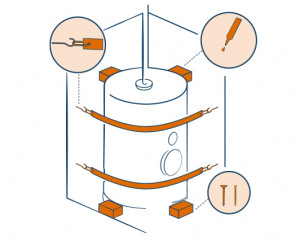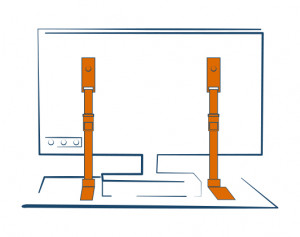Large furniture and appliances
Falling furniture and appliances, particularly tall or heavy items, can be a hazard during an earthquake. Secure these items and make your home safe in a disaster and every day.
Use brackets to secure tall and heavy furniture
Large items of furniture can move a lot during earthquake shaking. They can also be a hazard if young children climb on them. The good news is making these items safer is pretty straightforward.
A trip to the hardware store and some handiwork now may reduce damage as well as inconvenience to you and your family following a natural disaster.
To secure bookshelves and cabinets
You will need:
- two brackets for each piece of furniture
- screws to fit the brackets to the wall and to the furniture
a drill.
Follow these steps:
- Mark the wall where the top of the furniture comes to, then move the furniture from the wall.
- Find the studs in the wall by using an electronic stud finder or by tapping lightly and listening for the duller sound of the stud.
- Drill pilot holes into the wall stud for your screws. Take care when drilling to avoid electrical wiring that might be in the wall space.
- Use 63mm 12-gauge screws to screw the brackets into wall studs before moving the furniture back. To hide the brackets as much as possible, attach them as two upside Ls, with the bracket arm facing downwards against the wall.
- Screw the other arm of the bracket down onto the furniture with 15-25mm 8-gauge screws.
Fix. Fasten. Don't Forget.
Watch our video to see how to secure furniture to the wall.
Securing hot water cylinders
Securing a hot water cylinder is surprisingly easy, and something you can do yourself.
You can buy hot water cylinder restraint kits from hardware stores. These have the straps, screws and turnbuckle you need. Be sure to check the size of your water cylinder as those in excess of 200 litres require more than two straps.
Follow the manufacturers’ installation instructions or follow these steps:

- Screw or nail timber blocks to the floor or any shelving it sits in or alongside (make sure the shelf is fastened).
- Cut timber blocks to size so they fit snugly between the top of the cylinder and walls, then glue them into place. Ensure the blocks are fastened against the wall framing.
- Screw two 8 mm screw hooks into the studs on either side at the same level as the blocks.
- Attach a turnbuckle to one hook and the end of the strap. Cut the strap to the length you need, connect it to the other hook and use the turnbuckle to make it tight.
Use straps to secure whiteware
Household whiteware items like as fridges, washing machines and freestanding ovens can be very heavy. That means they can do a lot of damage if they fall over in a quake.
Restraint straps specifically designed for large appliances are available from hardware stores and online. These straps use an adhesive to stick to the top of the appliance and screws to attach the strap into a wall stud.
Use straps to secure televisions
Due to their tall and narrow shape, TVs are prone to toppling forward in a quake.
- Use specialist restraint straps to secure the TV to the furniture it sits on.
- A non-slip mat beneath the TV can also minimise movement, but should be used in conjunction with restraints.
External information
Personal safety
If a disaster happened tomorrow, would you be ready? Civil Defence explains how to make a plan before an emergency happens.
Local councils
Your local council has information you can use to reduce your risk during a natural disaster. Find yours here.
Our natural hazards
New Zealand has many natural hazards. GNS Science helps us understand what these are and how we can increase our resilience.